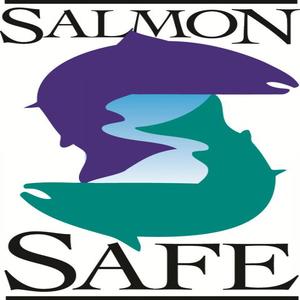

Salmon Safe

The product was produced in a way that protects salmon in the Pacific Northwest in order to allow them to reproduce.
Purpose
To transform land management practices so Pacific salmon can thrive in West Coast watersheds.
Applied Standards
Farm operation is not in violation of federal, provincial, state, or local environmental laws or associated administrative rules or requirements as determined by any regulatory agency through an enforcement action. Water rights are legal and farms have met monitoring and reporting requirements. Standard management practices used in day-to-day farm maintenance do not jeopardize salmon or their habitat, as determined by conformance with performance requirements in Part B of the Certification Standards. All pesticide use occurs within the context of an IPM process as documented in a comprehensive written strategy or as demonstrated or described during field assessment. Satisfactory progress is being made to address farm features and operations, such as irrigation ponds, road crossings or concrete-lined streams that may degrade salmon habitat. These restoration efforts may include those required by the Salmon-Safe assessor as well as projects already being undertaken by farm management. Stream channels provide habitat for salmonids and other aquatic species via naturally stabilized stream banks, meandering channel form and accumulations of large and small woody debris where hydrologically and geomorphically appropriate. Riparian areas are in good condition16 and sufficiently maintain and restore stream health. Riparian buffers are maintained, restored or unimpeded by structures or improvements.17 Degree of canopy cover is comparable to healthy ecological reference conditions, such that it provides adequate shade, wood recruitment, leaf litter supply, stream bank stability and filtration of sediment to maintain aquatic habitat functions. Wetlands are protected and wetland buffers established to the greatest extent operationally feasible. Wetland protection is prioritized to provide off-channel salmonid (fish) habitat, improved water quality, additional floodplain storage or other habitat benefits associated with proper wetland function. Irrigation practices are managed to avoid impacts to salmonids and other aquatic species. Soil is protected from erosion and sediment is not transported to downstream waterways or surface water bodies.31 Erosion is prevented using regionally adapted vegetative cover, mulch or other methods to prevent off-site movement of sediment. Best management practices (BMPs)33, such as filter strips, water quality treatment ponds, swales or other measures are used to prevent sediment from high erosion hazard areas including roads, steep slopes, dry gullies, animal watering and feeding locations and animal trails from reaching waterways. Soil fertility is maintained without excess nutrient runoff from cropland to surface waters and without nutrient leaching into shallow subsurface or groundwater...Proper handling, storage and disposal of potentially hazardous materials, including pesticides and agricultural waste, is critical to protecting streams, salmon and other wildlife. Livestock are managed to avoid excessive soil compaction, erosion and loss of vegetation cover while enhancing pasture condition. Conduct animal waste management activities that limit fecal contamination of streams and water bodies. Manage cultivated areas on the farm to encourage biodiversity. Using practices such as crop rotation and intercropping (the use of two or more crops together in combinations) supports beneficial insect diversity and adds residues of different crops to the soil, stimulating soil organism diversity and aiding nutrient and disease management. Manage cultivated areas on the farm in a manner that maintains long-term soil health, biodiversity, structure and fertility. Incorporate soil amendments, cover crops and plant residues as necessary to maintain soil. Compost, cover crops and tilled-in plant residues help increase biodiversity within the soil which can lead to competitive exclusion of food-borne pathogens, increased soil fertility and a more dynamic soil ecosystem. Implement farm practices that protect and maintain...
habitat for beneficial insects and wildlife within fields and field margins. Protect and restore permanent non-farmed areas, including forests, wetlands, marginal fields, unimproved grasslands, fence rows or other areas that are not actively farmed to promote refuges for biodiversity. Maintain connectivity between riparian, wetland, and upland habitats to the greatest extent operationally feasible.
